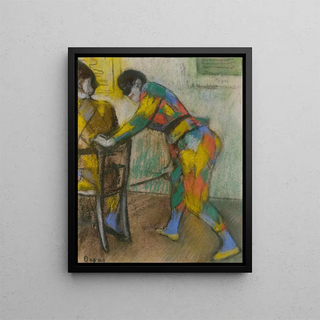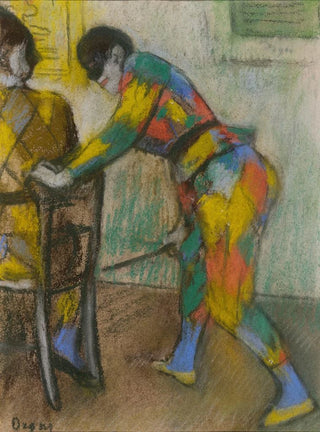Art print | Two Harlequins - Edgar Degas


View from behind

Frame (optional)
In the fascinating world of art, certain works stand out for their ability to capture fleeting moments of everyday life. The art print Deux Arlequins - Edgar Degas is a perfect example. This painting, created at the end of the 19th century, depicts a scene from Parisian life, where two characters, dressed in colorful Harlequin costumes, seem to engage in a silent dance. The composition, both dynamic and intimate, invites us to immerse ourselves in a world where movement and emotion subtly intertwine. Gazing at this piece, the viewer is transported into a vibrant atmosphere, where each brushstroke reveals a story in its own right.
Style and uniqueness of the work
Degas's style is characterized by a particular attention to the movements and expressions of his subjects. In Deux Arlequins, the artist skillfully plays with light and shadow, creating a striking contrast that highlights the shimmering costumes of the characters. The vibrant colors, combined with a fluid painting technique, give the work an almost choreographic dimension. The arrangement of the Harlequins, slightly offset, reflects a spontaneity reminiscent of cabaret shows of the era. Degas, a true master of observation, manages to immortalize a moment of life while revealing underlying melancholy. This blend of joy and sadness, so dear to the artist, makes this work a poignant testament to the human condition.
The artist and his influence
Edgar Degas, an emblematic figure of the Impressionist movement, transcended the conventions of his time. Although often associated with themes such as dance and ballet, his exploration of scenes from Parisian life, like that of the Harlequins, demonstrates his ability to engage with the diversity of human experiences. His innovative approach to perspective and composition influenced many artists, both contemporary and future. Degas captured the very essence of his subjects, whether dancers, women in baths, or café scenes, offering a unique and profoundly human vision. His legacy endures in

Matte finish

View from behind

Frame (optional)
In the fascinating world of art, certain works stand out for their ability to capture fleeting moments of everyday life. The art print Deux Arlequins - Edgar Degas is a perfect example. This painting, created at the end of the 19th century, depicts a scene from Parisian life, where two characters, dressed in colorful Harlequin costumes, seem to engage in a silent dance. The composition, both dynamic and intimate, invites us to immerse ourselves in a world where movement and emotion subtly intertwine. Gazing at this piece, the viewer is transported into a vibrant atmosphere, where each brushstroke reveals a story in its own right.
Style and uniqueness of the work
Degas's style is characterized by a particular attention to the movements and expressions of his subjects. In Deux Arlequins, the artist skillfully plays with light and shadow, creating a striking contrast that highlights the shimmering costumes of the characters. The vibrant colors, combined with a fluid painting technique, give the work an almost choreographic dimension. The arrangement of the Harlequins, slightly offset, reflects a spontaneity reminiscent of cabaret shows of the era. Degas, a true master of observation, manages to immortalize a moment of life while revealing underlying melancholy. This blend of joy and sadness, so dear to the artist, makes this work a poignant testament to the human condition.
The artist and his influence
Edgar Degas, an emblematic figure of the Impressionist movement, transcended the conventions of his time. Although often associated with themes such as dance and ballet, his exploration of scenes from Parisian life, like that of the Harlequins, demonstrates his ability to engage with the diversity of human experiences. His innovative approach to perspective and composition influenced many artists, both contemporary and future. Degas captured the very essence of his subjects, whether dancers, women in baths, or café scenes, offering a unique and profoundly human vision. His legacy endures in






